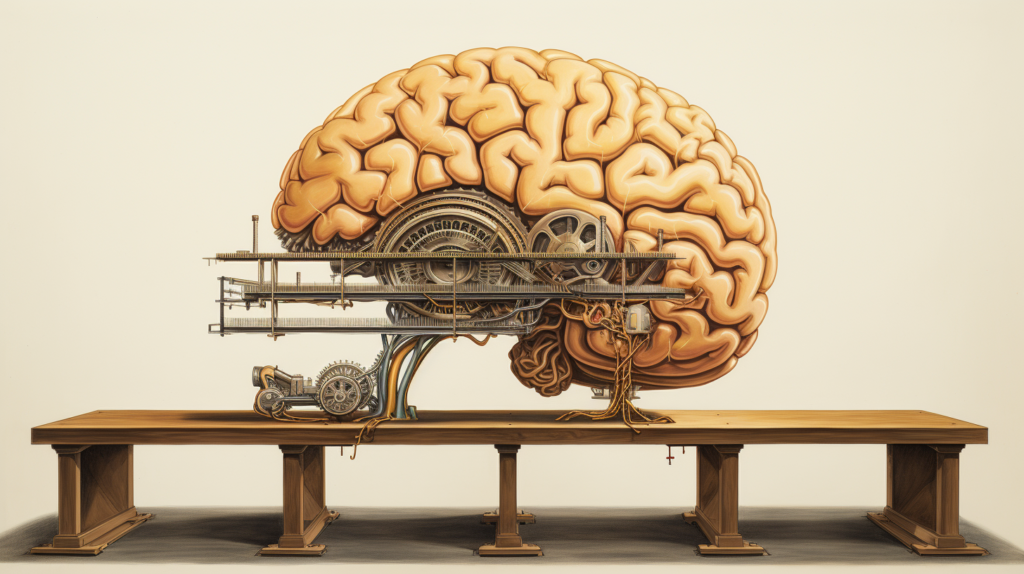
The Problem of Overthinking
As the digital age developed, it felt like I had discovered a kindred spirit. The boundless horizons of the online realm seemed to echo a deep, ever-growing curiosity I held within. Even as I lost myself in the intricacies of digital tech, there was a pull — from the mysterious realms of the metaphysical. Realms not made up of words or thoughts—not information-based. Whether I was exploring the wonders of New Age or immersed in the profound teachings of Buddhism, I yearned to find a bridge between these two worlds, each so different yet both close to my heart.
The challenge I faced? Articulating the elusive metaphysical realm in terms relatable to our everyday lives. My most profound realization throughout this exploration was that our thoughts, pervasive as they might be, aren’t always genuine reflections of reality. Often, they obscure our vision of our true selves, acting as hurdles on our quest for self-discovery. So, what really is the nature of overthinking? How can we align with our truest selves and reconnect with our core essence?
“The more you overthink the less you will understand.”
Habeeb Akande
Overthinking is like being stuck on a hamster wheel, always moving but never advancing. Though it may seem like we’re problem-solving, we often get lost in worries, fears, or societal pressures. Sometimes, it’s because we’re afraid of failing or being judged. Other times, past hurts still haunt us or we’re feeling the pressure from society to be perfect. It’s tricky because while it seems productive, it often keeps us from making real progress.
Signs and Symptoms of Overthinking
Constant Worrying — Besieged by persistent what if? scenarios about past or future events.
Analysis Paralysis — An inability to take action due to excessive deliberation.
Self-criticism — Continually finding fault in one’s actions or decisions, however minor they may be.
Regretting Past Decisions — Reliving past choices and wondering how things might have been different.
Difficulty Sleeping — Restless mind keeps us awake when stuck in revisiting the day’s events or anticipating future challenges.
Perpetual Fatigue — Mental exhaustion stemming from constant thinking can lead to persistent tiredness.
Indecisiveness — Struggling to make decisions, especially simple ones, due to the fear of potential repercussions.
Feeling Stuck — A sensation of no progress being made, regardless of the time and effort invested in thinking about a situation.
Compulsive Checking Behaviors — Frequently revisiting conversations, messages, or emails, scrutinizing them for perceived errors or alternate meanings.
Physical Symptoms — Such as headaches or stomachaches, which can sometimes be a result of stress caused by chronic overthinking.
Noticing these signs is like pausing to check in with ourselves, Hey, how am I really doing? By careful analysis to understand what’s truly going on beneath the surface, instead of just slapping a band-aid on the obvious issues, we can begin to create a calmer, clearer way of thinking and living. It’s about understanding ourselves better and taking steps that really count towards our well-being.
“I realized I have the power to choose whether I want to run my emotional circuitry (what I call my right brain) or my thinking circuitry (what I call my left brain)” Neuroanatomist
Dr. Jill Bolte Taylor
The Difference Between Left Brain vs Right Brain Thinking
Our brain has two sides — the logical left and the creative right. The left side is a detail-oriented project manager, providing structure and logic, while the right is the imaginative brainstormer, offering creativity and intuition, To thrive, we need both. Activities like doodling ignite our creativity, while puzzles sharpen logic. Dancing requires both rhythm — left-brained, and expression — right-brained. By utilizing both sides, we ensure a more balanced approach to our daily challenges and joys.
How our brains operate is rooted in real science, but sometimes, the way we talk about it makes it sound more like a fun myth than neuroscience. While it’s an oversimplification to say we’re either left-brained or right-brained,there’s no denying that understanding these aspects of ourselves can offer insights into our behavior and preferences.
Left Brain Characteristics
Analytical Thinking — Prefers approaching problems step by step, breaking them down into smaller components.
Logical Reasoning — Uses systematic methods to draw conclusions and make decisions.
Linear Processing — Processes information in a sequence, moving from one point to the next.
Language Skills — Associated with language processing, including grammar and vocabulary.
Right Brain Characteristics
Holistic Thinking — Looks at problems and situations as a whole, preferring to connect disparate pieces of information.
Intuitive Reasoning — Relies more on feelings and gut reactions than detailed analysis.
Spatial Abilities — Good at visualizing objects or scenarios and understanding how they fit into a broader context.
Creative Expression — Often linked with artistic endeavors, such as music, painting, and dance.
Right/Left Brain Examples in Society
Education — While traditional classrooms often focus on rote learning and ticking boxes, catering to left-brain activities, progressive teaching methods now blend in music, art, and imaginative play. Solving a math problem through a creative story or visual representation showcases the harmony of using both sides of the brain. This approach nurtures creativity and holistic growth beyond just memorization.
Workplace — In workplaces, some roles like accounting demand precision and logic, tapping into our left-brain skills. Programming, especially during the software design stage and algorithm creation, requires a harmony of both—analytical prowess for structuring code and creativity for innovative solutions. Fields like graphic design and music predominantly cater to our right-brain, valuing imagination, creativity, and the broader vision.
Culture & Media — Analytical talk shows and documentaries attract left-brained individuals with their structured arguments and detailed facts. Music festivals and abstract art exhibitions captivate right-brained individuals. A film that intricately blends a factual narrative with abstract symbolism showcases the seamless interplay of both sides of the brain, appealing to a broader spectrum of viewers and evoking a richer emotional response.
“Logic will get you from A to B. Imagination will take you everywhere.”
Albert Einstein

Are Thoughts Real? Understanding the Nature of Thoughts
Where do our thoughts come from and how do they connect to the world around us? For ages, deep thinkers—philosophers, scientists, and wise spiritual leaders, have been captivated by these very questions. Many of us, in quiet moments or during restless nights, wrestle with the puzzle of teasing apart what’s truly real from those ephemeral, ghost-like images dancing across our minds. Examining the nature of our thoughts is a path to understanding what ties us all together—a shared curiosity about the mysteries of the mind.
“The eye sees only what the mind is prepared to comprehend.”
Henri Bergson
What is a Thought?
What exactly is a thought? At its heart, a thought is like a story or image we create in our minds. While a physical sensation, like feeling cold or hot, directly interacts with our bodies, feelings are our emotional responses to these sensations or events. Thoughts are based on our memories, insights, worries, or hopes for the future. Everything, from a song we hear to a scent we recognize, can trigger these thoughts. Each thought is a reflection, sometimes crystal clear and sometimes a bit hazy, of our experiences, beliefs, feelings, and even the very space we’re in.
Thoughts vs. Reality
The distinction between thoughts and reality is vital to our mental health and understanding of the world. For instance, one might have a thought like Nobody likes me based on an isolated incident, but this doesn’t make it an objective truth. Consider another example — if you watch a terrifying movie about sharks and later find yourself hesitating to swim in a pool, it’s not the actual threat of sharks that scares you, but the residual thought or emotion from the movie. I never went into the ocean again after seeing “Jaws.”
The Dalai Lama once said,
“Remember that sometimes not getting what you want is a wonderful stroke of luck.”
This speaks to the idea that our thoughts and desires, while potent, don’t always align with what’s best for us in reality. Just because we think we want something doesn’t mean it’s the best thing for us.
In stressful situations, it’s common for people to jump to the worst-case scenario in their minds, even if the actual likelihood of that event is low. For example, forgetting to send an important email might trigger thoughts like I’m going to get fired, but in reality, mistakes happen, and most can be rectified.
Mindfulness meditation offers a gentle invitation to observe our thoughts without criticism, acknowledging their transient nature. Through this nurturing practice, we come to understand that we are not defined by our thoughts. We are the compassionate observer, noticing the ebb and flow of our thoughts and recognizing they don’t always hold the absolute truth.Instead our conception of reality is based on how we experience the world, not what we think of it.
As meditation expert Jon Kabat-Zinn put it,
“You can’t stop the waves, but you can learn to surf.”
Unless you saw “Jaws.”
Eckart Tolle has this to say about thinking,
“The primary cause of unhappiness is never the situation but your thoughts about it.”
While thoughts have the power to influence our emotions, decisions, and actions, they are not an undeniable reflection of reality. Recognizing the transitory and sometimes deceptive nature of thoughts is vital to understanding that not every thought that pops up is a direct ticket to the truth.
Some are like those clouds momentarily blocking the sun, while others are mere daydreams or old tales we tell ourselves. By understanding how our thoughts can be tricksters, we give ourselves the freedom to breathe, stay rooted in the present, and live a more joyful, balanced life. You are not your thoughts.
“A thought is harmless unless we believe it. It’s not our thoughts, but our attachment to our thoughts, that causes suffering.”
Byron Katie

Where Do Thoughts Come From? The Science Behind Thought Generation
Our minds are truly intriguing. One moment, we’re deep in a childhood memory, and the next, we’re replaying a tune from last week. But where do these thoughts come from? Why do certain ideas just stick, while others fade away? Understanding the birth and progression of our thoughts can offer insight into our own behaviors and feelings. How do our thoughts originate and evolve?
The Neural Pathways and Thought Generation
Wei-Chung Allen Lee of Harvard Medical School leads the research on how these neurons connect,
“The brain is structured so that each neuron is connected to thousands of other neurons, and so to understand what a single neuron is doing, ideally you study it within the context of the rest of the neural network.”
Check out the link to Lee’s article below for a more extensive explanation, but let me give you a snapshot—think of our brain as a bustling city, with neurons as its inhabitants. These neurons communicate via bridges known as synapses. Lee highlights this in the emerging field of study, referring to them as connectomics. Just like paths form in a park based on where people frequently walk, our experiences shape these neural pathways.
When you learn something new or think about a past memory, your brain pathways light up. They’re influenced by what we focus on and what quietly plays out in our subconscious. It’s the dynamic interplay of these countless neural conversations that continuously form our stream of consciousness, giving rise to thoughts, memories, and feelings.
Conditioned Responses
Pavlov’s experiments with dogs provide a clear example of conditioned responses. He demonstrated that when a bell was repeatedly paired with food, the dogs began to salivate at the sound of the bell, expecting food. In a similar vein, if you were bitten by a dog as a child, later encounters with a dog might trigger feelings of anxiety or fear. These reactions stem from conditioned neural pathways formed by previous experiences.
Repetition and Reinforcement
The first few times you drive to a new place, you’re highly attentive, but after several repetitions, you can almost drive there on autopilot. This is due to the reinforcement of a particular neural pathway. The same applies to thoughts. The more frequently you engage with a specific thought, the stronger that neural pathway becomes, making the thought more easily accessible and dominant in your mind.
External Stimuli
The simplest things, like the scent of a particular perfume, can whisk us back in time, maybe to a moment we shared with someone special. Or the gentle patter of raindrops can suddenly make us recall a cozy vacation cabin we once stayed in years ago. These stimuli wake up parts of our brain connecting today’s experience with past moments, making our world feel interconnected and brimming with stories.
Emotional States
Our emotions act like a filter for our memories and thoughts. When we’re having a down day, our mind plays a reel of all those other times we felt the same way, pulling up memories tinted with sadness. On the other hand, when we’re on top of the world, our brain becomes this highlight reel of all the good times. It’s as though our heart sets the mood, and our mind crafts the playlist, echoing our current feelings with memories of similar emotions from the past.
Subconscious Processing
Many scientists, especially those in the fields of psychology and neuroscience, have studied the significance of dreams. Our dreams provide insight into our subconscious, weaving tales from memories, emotions, and hopes. It’s fascinating how they can create scenarios from fragments of events, wishes, and fears. Reflecting on them can reveal our deep desires and feelings, allowing us to connect more profoundly with our innermost self.
“Dreaming provides a unique suite of benefits to all species fortunate enough to experience it, humans included. Among these gifts are a consoling neurochemical bath that mollifies painful memories and a virtual reality space in which the brain melds past and present knowledge, inspiring creativity.”
Matthew Walker, neuroscientist and author of “Why We Sleep”
Taking Charge of Our Thoughts
Navigating our thought patterns can be transformative in shaping our mindset. When we consistently lean into positive thoughts, it’s akin to treading a familiar mental path, making it more instinctive with each journey. Conversely, by confronting and questioning negative or unproductive thoughts, we begin to let that path grow over, visiting it less often.
It’s essential to strike a balance—while nurturing positive thoughts can uplift us, detaching from them occasionally reminds us that they, just like their negative counterparts, are impermanent and not always rooted in reality. Recognizing this can help us maintain a grounded perspective, ensuring we don’t get overly attached to any single thought pattern.

The Dangers of Being Controlled by Your Thoughts
Understanding our thoughts can greatly influence how we shape our thinking. When we consistently think positively, it becomes a familiar process, making it easier to foster such thoughts in the future. However, constantly dwelling on negative thoughts can hinder our progress and decision-making. It’s essential to be cautious.
While over-indulgence in negative thinking can paralyze us, being overly positive might prevent us from seeing the full spectrum of our choices. To function effectively, it’s beneficial to strike a balance—be hopeful but remain open to all possibilities. We have a saying in the backcountry where life can be challenging—Hope for the best, but prepare for the worst.
Anxiety and Overthinking
Replaying worrisome moments in our heads can become burdensome. It’s like watching the same cringe-worthy movie scene on repeat. If after a gathering, you’re stuck on something you said, it might make you anxious about future meet-ups. Over time, such overthinking can diminish our peace of mind, pulling us away from the present joys amd meaningful relationships.
Impaired Decision Making
Relying solely on momentary emotions to dictate our choices can sometimes backfire. We can make impulsive purchases when we’re particularly hungry or emotional, only to later wonder if it was the right decision. During the COVID lockdown, the immediate loneliness many felt led to a surge in pet adoptions. But as life started returning to its usual pace, the permanent responsibility of pet ownership hit home, leading to many animals being returned. This underscores the importance of pausing and considering the long-term implications of our actions, distinguishing between genuine feelings and fleeting thoughts.
Strained Relationships
You’re having an off day, and those familiar insecurities begin to lurk. You text a friend—they don’t reply instantly. It’s tempting to think, They’re upset with me. But perhaps they’re just busy or distracted. Acting on these hasty assumptions can lead to needless tension. Our thoughts don’t always accurately depict others’ intentions. A pause and some perspective can save many a friendship from unintended rifts.
Stagnation and Missed Opportunities
You dream of opening a café, with its warm atmosphere and aroma of coffee. Yet, a voice whispers, What if I fail? Such doubts, while meant to protect, can sometimes hold us back. Yielding to these fears keeps us in our comfort zones, where dreams might stall. By recognizing but not surrendering to these doubts, we invite endless possibilities and adventures into our lives.
Decline in Mental and Physical Health
Persistent stress from over-thinking affects not just our minds but our bodies. It can cause headaches and digestive issues, and weaken our immune system. Extended periods of stress may lead to conditions like depression or heart problems, underscoring the deep link between mental and physical well-being. Change happens in the mind first.
Distorted Reality Perception
Ever had a day where everything seems against you? A spilled coffee, an unsent email, or a perceived odd look from a coworker can tint our perspective, making innocent events feel threatening. At a gathering, you might spot friends whispering and think, Are they talking about me? when they’re just discussing shoes. These patterns can make the world feel hostile, leading to misunderstandings with loved ones. Recognizing and challenging these thoughts helps us see the world more clearly and fairly.
Reduced Self-esteem and Self-worth
The consistent hum of self-doubt in our heads can erode our confidence, making us feel unworthy or inadequate. This negative self-talk isn’t just a mental burden—it’s tied to real challenges we face, from deep insecurities to body image issues. Everyone has their battles, and it’s vital to seek help when needed. Catching these thoughts early is key. Whether it’s through meditation, journaling, or therapy, understanding and redirecting our thoughts helps us lead fulfilling lives on our terms.
“Negative self-talk diminishes us, limits us, and can even become a self-fulfilling prophecy.”
Melody Beattie

How to Train Your Brain to Stop Overthinking
Overthinking is like a treadmill—your mind races, but you’re stuck in place. It’s exhausting to exert energy without making progress. Just as we change our workouts for better results, we can train our mind to move past this cycle. By strengthening our mental muscles and using the right strategies, we can guide our thoughts toward a more balanced and healthier direction.
Set Aside “Thinking Time”
Allocate a specific period in your day, say 20 minutes, solely for reflection and introspection. Use this time to process events, plan ahead, or ponder decisions. For instance, if you’re unsure about a decision at work, use this window to weigh pros and cons. Outside of this timeframe, consciously redirect your mind when you catch it drifting into overthinking.
The “Not Now” Technique
Whenever you find yourself beginning to overthink outside your designated thinking time, mentally tell yourself Not now. Softly, without judgment. It’s a simple way of acknowledging the thought without engaging in it. I also find it helpful to say You are not real when my thoughts start shaping my reality.
Journaling or Writing
Putting pen to paper can be really helpful. It’s a simple way to sort out how you feel. If you’re nervous or anxious about something, writing it down can help you pinpoint why. Sharing your thoughts, whether they’re in the form of a real-life story, fiction, or a poem, on platforms like Medium can also be a way to work through things. It’s all about what feels right for you.
Mindfulness and Meditation
Meditation and mindfulness go beyond being just trendy terms—they serve as compasses to navigate our mind’s incessant noise. Integrating them into our daily routines allows us to become more attuned to our internal dialogues. Mindfulness meditation, in particular, encourages us to observe our thoughts without labeling them as good or bad.
By focusing on the breath or bodily sensations, we learn to recognize our thoughts without getting lost in them or assigning value. This is the heart of mindfulness meditation. With time and practice, this approach can help mitigate the intensity and frequency of overthinking episodes.
Challenge Your Thoughts
Ask yourself if the thought you’re stuck on is realistic. For example, if you’re obsessing over a mistake, ask yourself Will this matter in five years? I often ask myself, How important will this be after I’m dead? Not many thoughts get any points these days. Often we blow things out of proportion, and challenging our thoughts can help us see situations more objectively.
Set Clear Boundaries
Ever been scrolling on social media and a post suddenly has you second-guessing yourself? It’s a fast slide into comparisons and self-doubt. Combat this by pinpointing what triggers your overthinking online. Maybe some accounts need an unfollow. Prioritize creating a digital space that uplifts rather than drags you down. Your peace of mind is invaluable.
Physical Activity
A good walk or a yoga session can clear your head. That’s because moving our bodies isn’t just good for our muscles — it’s a balm for the mind too. Yoga offers the added benefits of improving flexibility, enhancing breath control, and promoting a deeper connection between mind and body.
Getting active, whether it’s diving into a yoga sequence or simply taking a stroll around the block, gives our minds a break from the constant chatter. Plus, there’s the bonus of feel-good endorphins that come with exercise, helping those worries to fade and lifting our spirits.
Talk It Out
Got a thought that won’t leave you alone? Sometimes, just talking it out helps. Voicing your thoughts can be like airing out a stuffy room. A trusted friend might offer a new perspective or simply listen, letting you process. Often, just having someone say, I hear you, makes all the difference. A listening ear can be a game-changer against overthinking.
Cognitive-Behavioral Techniques to Manage Thoughts
Cognitive Behavioral Therapy (CBT) is a toolkit for your mind. It helps us challenge unhelpful thoughts. Worried about a presentation and think, I’ll mess up? Instead of spiraling into that thought, CBT teaches you to stop and ask yourself, What’s the evidence for this? Have I done this before and succeeded? When you start looking closer, you might find there’s little to no proof backing up your fear. It’s about facing challenges with clarity and confidence.
The Power of Positive Affirmations
Affirmations are tools for reshaping our mindset. Instead of Everything will be perfect, saying I can handle challenges is more empowering and realistic. They’re not about avoiding thoughts but steering them gently. With consistent effort and practice, it’s possible to guide your brain towards more constructive and positive thought patterns, ensuring overthinking doesn’t rob you of the joy and peace of the present moment.
Be in the Present Moment
Being free from overthinking is like soaking in a sunset without dissecting the science behind it. It’s savoring a dish or feeling a song without analyzing every detail. It’s living in the moment, without pausing to predict the next.It’s about simply being present and letting go of those incessant thoughts.
Tap into Spontaneous Joy
Life is a river with moments of pure joy. Overthinking is the debris blocking its flow. When we’re trapped in our thoughts, we miss life’s spontaneous beauty. By being present and clearing our mind, we appreciate life’s richness. It’s about balancing deep introspection with living in the moment, savoring the magic life offers. What do you hear as you walk through the forest? Your thoughts or the sounds of life?
Reveling in Life’s Simplicities
Life’s deepest joys are in simple moments, like a child’s laughter or a peaceful morning. Often missed in our busy lives, these moments are pure happiness. When not lost in overthinking, we open ourselves to these experiences, connecting deeper with the world. We look out and see the beauty of the world rather than get stuck in a myopic vision of unrealistic thoughts.
Strengthening Connections
Genuine relationships thrive when we’re present. By setting aside overthinking, we deeply connect and listen to others. Instead of analyzing every word or gesture, we can cherish shared moments. We can accept people for who they are without judgment and see ourselves with the same compassion. It’s less about the noise in our heads, and more about feeling the heartbeats of those we’re with.
Empowering Decision-Making
When we let go of the constant chatter of overthinking, making choices becomes so much clearer. We’re no longer bogged down by the what ifs or the exhaustive list of pros and cons. Instead, we lean into our gut feelings and our past experiences, giving us the confidence to take decisive steps forward. It’s like finally seeing a clear path after being lost in a thick fog of thoughts for so long.
Cultivating Peace
Inner peace often eludes the chronic overthinker. By managing overthinking, we find stillness amidst life’s noise. This quiet allows clarity and contentment to emerge. Being present, rather than lost in thought, we often discover what truly matters, seeing things more clearly and feeling genuinely at peace with ourselves and the world.
Gratitude Practice
Gratitude is like a warm embrace for our minds, especially when overthinking starts to take hold. By pausing to cherish the good moments and simple joys, we root ourselves firmly in the present and surround our minds with feelings of contentment. Making it a habit to recognize and share our thankfulness helps us shift from focusing on what we might be lacking or worrying about, to celebrating the many blessings we already have. This gentle shift doesn’t just ease overthinking—it also enriches our emotional well-being, making us feel more connected and content.
In Service
Service to others acts as a powerful antidote to overthinking. When we direct our energies toward helping someone else, we shift our focus outward, diverting attention from our own obsessive ruminations. Engaging in acts of kindness and service provides a sense of purpose, grounding us in tangible actions with clear benefits. This outward focus not only alleviates our tendency to overanalyze but also fosters feelings of connection and fulfillment, reinforcing the idea that our thoughts don’t have to control our actions or dictate our well-being.
“When we give cheerfully and accept gratefully, everyone is blessed.”
Maya Angelou

Final Thoughts
Our minds can be a maze at times, but we hold the map. By getting to know what makes us overthink and finding ways to get off the hamster wheel of thoughts, we can truly feel and enjoy every little moment life offers. It’s not just about turning down the volume of our busy minds, but really tuning in to the beautiful sounds of life around us.
If there’s one thing I want you to hold onto, it’s this—thoughts aren’t the same as reality! Next time you lose yourself in your thoughts, take a breath, step back and loosen the reins.
If you’re intrigued by the intricate workings of the mind, consider exploring these references. They encompass a blend of scientific studies, self-help literature, and insightful philosophical and contemplative writings probing the depths of our mental landscape.
Scientific Literature & Books
Harvard Medical School — A New Field of Neuroscience Aims to Map Connections in the Brain
Jill Bolte Taylor — Neuroanatomist whose research specialized in understanding how our brain creates our perception of reality — My Stroke of Insight
Kabat-Zinn, J. (1994). Wherever you go, there you are: Mindfulness meditation in everyday life. Hyperion. Based on the principles of Mindfulness-Based Stress Reduction (MBSR), a program Kabat-Zinn developed at the University of Massachusetts Medical School. The program and its effectiveness have been the subject of scientific research.
Leonard Shlain was a prominent surgeon and author who wrote several books exploring the intersections of art, science, and culture.
Nolen-Hoeksema, S. (2000). Women Who Think Too Much: How to Break Free of Overthinking and Reclaim Your Life
Gazzaniga, M. S. (1998). The split brain revisited. Scientific American.
Beck, A. T., Rush, A. J., Shaw, B. F., & Emery, G. (1979). Cognitive therapy of depression. Guilford press
Contemplative Traditions & Philosophical Texts
Tolle, E. (2005). A new earth: Awakening to your life’s purpose. Penguin
Hanh, Thich Nhat. (1999). The miracle of mindfulness: An introduction to the practice of meditation. Beacon Press
Dalai Lama & Cutler, H. C. (1998). The Art of Happiness. Riverhead Books
Self-Help & Popular Psychology
Duhigg, C. (2012). The power of habit: Why we do what we do in life and business. Random House
Clear, J. (2018). Atomic habits: An easy & proven way to build good habits & break bad ones. Avery
Gilbert, D. (2006). Stumbling on happiness. Vintage
Websites & Articles
Psychology Today — articles on overthinking, mindfulness, and cognitive-behavioral therapy
Harvard Business Review — articles on decision-making, leadership, and mindfulness
Mindful.org — for articles and practices centered around mindfulness
All images created by Author in Midjourney
The article originally appeared on my Medium Blog. You can check out more of my stories there.
Remember not to miss any of Solitude Reflections and join our email list! And don’t forget to check out the calming meditations on the Breathe page. Can you identify your thought patterns? Which pathways you are reinforcing? Share your thoughts by clicking ‘Comments’ at the top. Your feedback is essential and valued.
Until next time, stay well out there and say no to negative self-talk.
With love, Gael
Written on the Shoshone-Bannock Ancestral Lands in Eastern Idaho















Beautiful.
Beautiful.
Oh, to just practice and live and love in agape's shield.
Deeply moving article. Suicide affects so many. I've had two people I was veryclose to, take their lives by suicide.…
I deeply enjoy your musings. To this one I reply, body shaming in our techno world is chronic. And social…